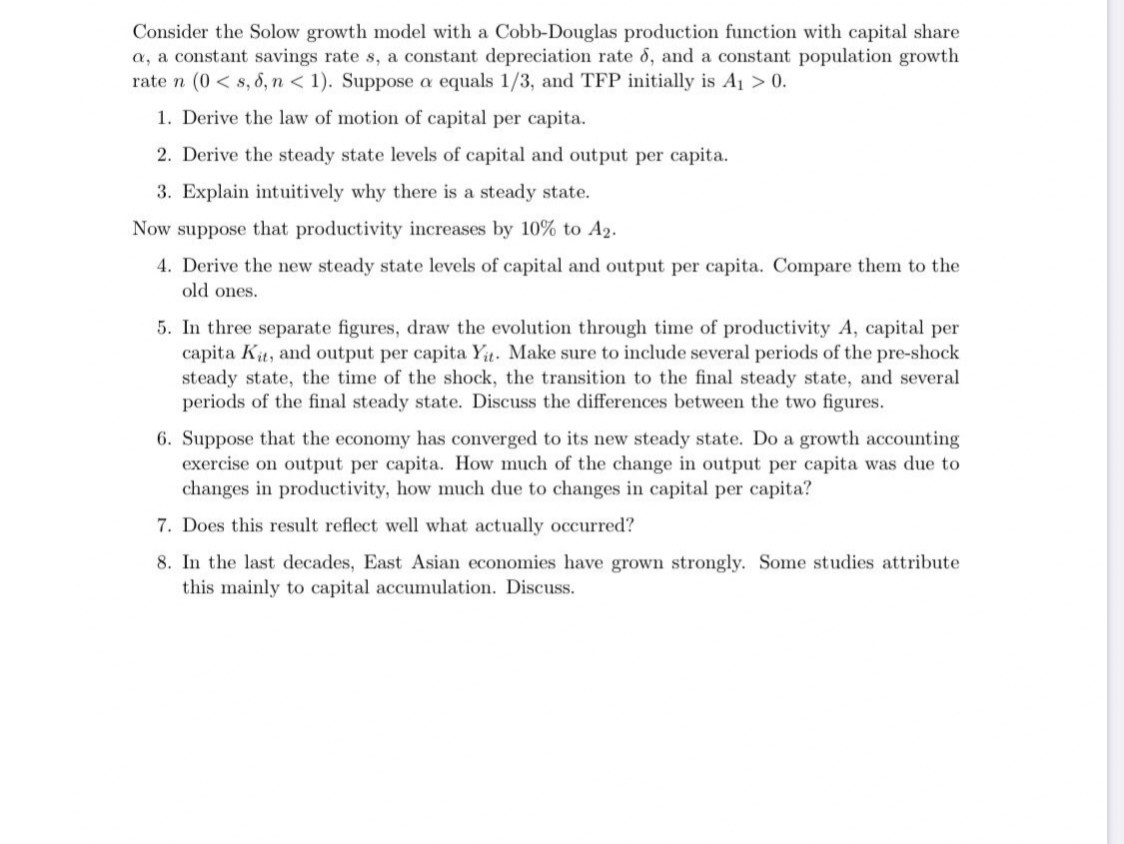Consider the Solow growth model with a Cobb-Douglas production function with capital share a, a constant savings rate s, a constant depreciation rate 8, and a constant population growth rate n (0< s, 6, n < 1). Suppose a equals 1/3, and TFP initially is A1 > 0. 1. Derive the law of motion of capital per capita. 2. Derive the steady state levels of capital and output per capita. 3. Explain intuitively why there is a steady state.
Consider the Solow growth model with a Cobb-Douglas production function with capital share a, a constant savings rate s, a constant depreciation rate 8, and a constant population growth rate n (0< s, 6, n < 1). Suppose a equals 1/3, and TFP initially is A1 > 0. 1. Derive the law of motion of capital per capita. 2. Derive the steady state levels of capital and output per capita. 3. Explain intuitively why there is a steady state.
Chapter1: Making Economics Decisions
Section: Chapter Questions
Problem 1QTC
Related questions
Question

Transcribed Image Text:Consider the Solow growth model with a Cobb-Douglas production function with capital share
a, a constant savings rate s, a constant depreciation rate 8, and a constant population growth
rate n (0 < s, d, n < 1). Suppose a equals 1/3, and TFP initially is A1 > 0.
1. Derive the law of motion of capital per capita.
2. Derive the steady state levels of capital and output per capita.
3. Explain intuitively why there is a steady state.
Now suppose that productivity increases by 10% to A2.
4. Derive the new steady state levels of capital and output per capita. Compare them to the
old ones.
5. In three separate figures, draw the evolution through time of productivity A, capital per
capita Kit, and output per capita Yit. Make sure to include several periods of the pre-shock
steady state, the time of the shock, the transition to the final steady state, and several
periods of the final steady state. Discuss the differences between the two figures.
6. Suppose that the economy has converged to its new steady state. Do a growth accounting
exercise on output per capita. How
changes in productivity, how much due to changes in capital per capita?
of the change in output per capita was due to
7. Does this result reflect well what actually occurred?
8. In the last decades, East Asian economies have grown strongly. Some studies attribute
this mainly to capital accumulation. Discuss.
Expert Solution
This question has been solved!
Explore an expertly crafted, step-by-step solution for a thorough understanding of key concepts.
Step by step
Solved in 3 steps with 3 images

Knowledge Booster
Learn more about
Need a deep-dive on the concept behind this application? Look no further. Learn more about this topic, economics and related others by exploring similar questions and additional content below.Recommended textbooks for you


Principles of Economics (12th Edition)
Economics
ISBN:
9780134078779
Author:
Karl E. Case, Ray C. Fair, Sharon E. Oster
Publisher:
PEARSON

Engineering Economy (17th Edition)
Economics
ISBN:
9780134870069
Author:
William G. Sullivan, Elin M. Wicks, C. Patrick Koelling
Publisher:
PEARSON


Principles of Economics (12th Edition)
Economics
ISBN:
9780134078779
Author:
Karl E. Case, Ray C. Fair, Sharon E. Oster
Publisher:
PEARSON

Engineering Economy (17th Edition)
Economics
ISBN:
9780134870069
Author:
William G. Sullivan, Elin M. Wicks, C. Patrick Koelling
Publisher:
PEARSON

Principles of Economics (MindTap Course List)
Economics
ISBN:
9781305585126
Author:
N. Gregory Mankiw
Publisher:
Cengage Learning

Managerial Economics: A Problem Solving Approach
Economics
ISBN:
9781337106665
Author:
Luke M. Froeb, Brian T. McCann, Michael R. Ward, Mike Shor
Publisher:
Cengage Learning

Managerial Economics & Business Strategy (Mcgraw-…
Economics
ISBN:
9781259290619
Author:
Michael Baye, Jeff Prince
Publisher:
McGraw-Hill Education